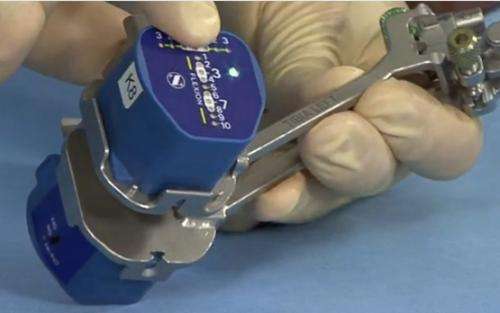Improving knee replacements

(Medical Xpress)—Each year, approximately 600,000 total knee replacement procedures are performed in the United States, a number that is expected to rise exponentially in the next decade as the population ages. Successful surgeries require precise alignment in the knee, a challenging task made even more daunting by the expected rise in procedures. To help meet this demand, UC San Diego Health System is the first in the nation to use iASSIST, a computer navigation system with Bluetooth-like technology that improves surgical precision and accuracy in total knee replacements, decreasing the need for revision surgery.
The FDA-approved iASSIST device, designed by Zimmer Holdings, Inc., allows the surgeon to verify each surgical step, such as bone cuts and overall alignment, in real time, reducing mechanical errors during total knee replacements. The device is made up of small electronic pods, which are essentially mini-computers with wireless technology similar to smartphones. These electronic pods snap onto conventional instruments used in knee replacement surgery. By simply moving the knee in different positions during surgery, the device registers the anatomic axis of the leg unique to that patient, which guides each bone cut and ultimately places the knee implant in a more accurate alignment.
"This innovative technology allows us to deliver a more personalized knee to the patient and provide extreme accuracy in implant placement. Studies have shown that total knee replacement surgery has a higher failure rate when the knee is mal-aligned. This device enables orthopedic surgeons to restore a patient's normal alignment with precision in a reproducible fashion, decreasing revision surgery and providing a more natural feel of the implant for the patient," said Francis Gonzales, MD, with the Department of Orthopedic Surgery.
Current robotic and computer-assisted systems are less efficient and rely upon additional equipment, such as a large computer monitor in the operating room. The new device, about two inches wide, is the only piece of equipment needed to guide surgeons during a knee replacement. There are other patient-specific instruments available, said Gonzales, but the patient must undergo additional procedures, such as computed tomography (CT) scans or magnetic resonance imaging (MRI) prior to surgery.
"The iASSIST system allows us to bypass additional imaging and still get a patient-specific knee. This technology is quite intuitive and adds accuracy and precision to our instruments, giving us the ability to restore mechanical alignment with all patients regardless of their deformity," said Gonzales.
Diana Mertrude, a retired nurse, is among the first patients at UC San Diego Health System to have the device used during her left knee replacement.
"I am very active with tennis, running and skiing, but due to arthritis, my left knee was getting progressively worse and painful," said Mertrude. "I could feel my knee give out every time I walked, and I knew it was time for a knee replacement."
Arthritis is the number one cause for joint replacement surgeries. The procedure consists of replacing the diseased or damaged joint surfaces of the knee with metal and plastic implants that allow continued motion of the knee.
Mertrude was discharged three days after surgery. She walked out of the hospital unaided and was able to climb the stairs in her home that same day.
"Three months after surgery, I was able to continue my passion for tennis and have experienced no problems with my knee," said Mertrude. "The surgery truly improved my quality of life."
Mertrude recently had her right knee replaced using the same technology and is looking forward to a cross-country motorcycle ride with friends and family this spring.
Gonzales trains other orthopedic surgeons across the nation on how to use the device and the benefits of its implantation. He is currently conducting research comparing the new system to conventional instruments in total knee replacements.
















